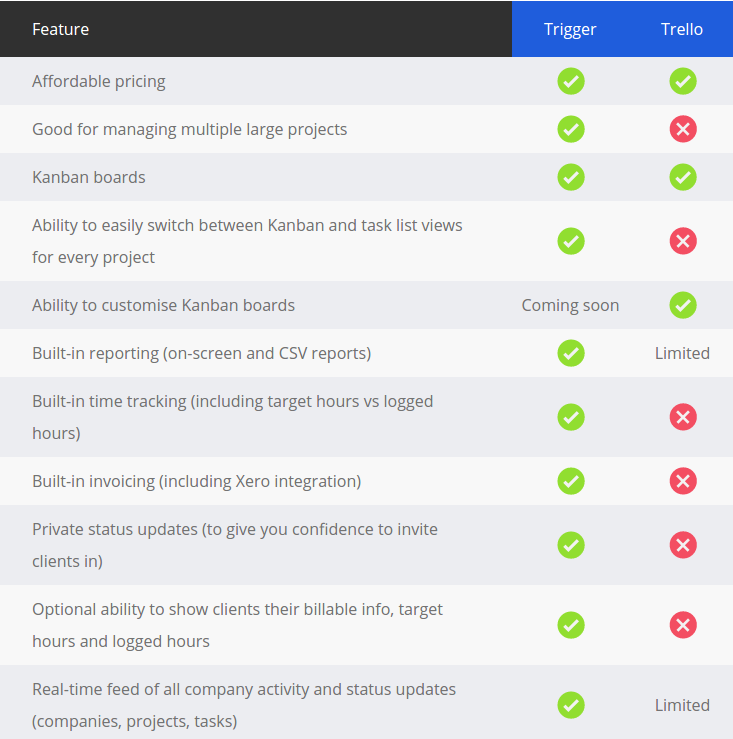Making headlines earlier this year when it was sold for $425 million, the project management app Trello is, and will always be, a force to be reckoned with.
But whilst you can run work projects on Trello - the unofficial king of Kanban boards, is it really the best product for agencies and consultancies with more than a few team members and projects?
We think not. Here are ten reasons why we think Trigger (built locally here in Brisbane, and integrated with Slack, just like Trello) is the best alternative to Trello (built 15,520km away by Fog Creek Software in New York).
1. Better for managing multiple large projects
Trello can be a great starter tool for small teams with a limited number of projects. But if you Google “what do people dislike about Trello?” you’ll find the common consensus is that it’s easy to outgrow Trello. At the point when you want need the ability to better manage multiple large projects, we propose that Trigger is your best alternative to Trello.
This is because Trigger offers much more than Trello’s famous boards and cards: Trigger is a full-blown project management solution with time tracking against tasks, easy internal and external collaboration, built-in reporting, built-in invoicing and more.
2. Ability to easily switch between Kanban and task list views for every project
The beauty of Trigger’s Kanban boards is that you can easily switch between each project’s Kanban and task list views at any time.
Whereas Trello only allows you to have Kanban boards or…. you guessed it… Kanban boards. This makes Trello even less flexible than another heavyweight in the project management space: Asana. Asana has no way for you to easily switch between the two views (you must nominate one view only at the time you set up a project), but at least Asana gives you two views.
3. Built-in reporting (on-screen and CSV reports)
Trello offers CSV reporting on a project basis, but as one of the critics on Quora says, Trello has a “lack of detailed reporting without adding multiple Gmail extensions”. This is not an ideal solution, because not only do you potentially have to pay for extensions and/or Power-ups, another critic noted that “the problem with integrations is that they can never be completely seamless”.
Trigger offers expansive on-screen and CSV report options and very soon we’ll be launching a dedicated Reports tab that will offer even more insights to help you know exactly what’s going on in your business.
Current management reports in Trigger include:
- Company, Project, Task, Task Description, Status, Assignee, Due Date, Logged Hours, Total Hours, Employee, Employee Hours
- Tag, Company, Project, Task, Task Description, Status, Assignee, Due Date, Logged Hours, Total Hours
- Company, Project, Task, Billable Status, Logged Hours
- Uninvoiced Companies with Billable items
- Timesheets (by Company, by Date and/or Employee)
- Monthly revenue
- Billable hours
- My hours
4. Built-in time tracking (including target hours vs logged hours)
For a business owner or project manager, time tracking can genuinely mean the difference between losing money, breaking even or making a profit.
So, if you run a service-based business and you want to accurately track how long it takes to complete tasks, Trigger’s built-in time tracking could be a life-changer because it can help you stop overservicing clients and start increasing your business’ profitability.
5. Built-in invoicing (including Xero integration)
Trigger has built-in invoicing functionality, because it’s been designed from the outset as an all-in-one project management solution. Trello does not have built-in invoicing and when we looked for an add-on in the Trello Power Ups section, we could not even find a dedicated invoicing add-on for Trello.
And if you use Xero for your invoices, you can sync Trigger with Xero and never have to double-handle an invoice again!
6. Private status updates (to give you confidence to invite clients in)
Trello doesn’t allow private status updates, which might explain why some Trigger customers have told us that they were always nervous about inviting clients into Trello (before they swapped over to using Trigger).
Trigger definitely gives you the ability to make private status updates, so your internal conversations stay private and only the conversations you’re happy for your clients to see (and collaborate on) are made public.
7. Optional ability to show clients their billable info, target hours and logged hours
If you want greater transparency for your clients, you’ll love Trigger’s (optional) ability for you to show your clients their billable information (not your internal costs, by the way), target hours and logged hours.
This was a feature requested by one of our customers in Spain who has more than 60 clients using the Trigger platform - for free!
8. Real-time feed of all project activity
If you want the ability to run your eyes down a real-time feed of all activity on your account each day, Trello can’t help you as well as Trigger can.
Trello can offer a Kanban board view of project activity, but Trigger gives a real time feed of all company, project and task entries and status updates. This is in addition to our email notifications for updates and @mentions (set at your frequency preferences), as well as our in-app notifications for @mentions.
9. Responsiveness to customer requests
Unlike some of the big names in the project management field, at Trigger we try to be super responsive to our customer’s changing needs and requests. We’re adding customer-requested features and improvements all the time, so if you have an awesome idea for us, don’t hesitate to reach out to us here.
